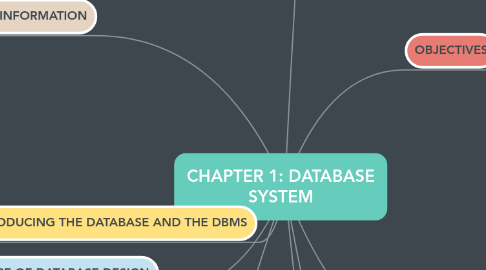
1. DATA VS INFORMATION
1.1. Data are raw facts
1.1.1. Raw data must be formatted for storage, processing, and presentation
1.1.2. Data are the foundation of information, which is the bedrock of knowledge
1.1.3. Building blocks of information
1.2. Information is the result of processing raw data to reveal meaning
1.2.1. Information requires context to reveal meaning
1.2.2. Information produced by processing data
1.2.3. Information used to reveal meaning in data
1.2.4. Accurate, relevant, timely information is the key to good decision making and organisational survival
2. INTRODUCING THE DATABASE AND THE DBMS
2.1. Database
2.1.1. Shared, integrated vomputer structure that stores a collection of data
2.1.2. End user data : raw facts of interest to the end user
2.1.3. Metadata : data about data
2.1.3.1. Provides description of data characteristics and relationships in data
2.1.3.2. Complements and expands value of data
2.2. Database management system (DBMS)
2.2.1. Manage structure and control access to data
3. TYPES OF DATABASE
3.1. Single - user database
3.1.1. Desktop database- single user, runs on PC
3.2. Multiuser database
3.2.1. Workgroup database supports a small number
3.2.2. Enterprise database supports a large number
3.3. Centralized database
3.3.1. Data located at single site
3.4. Distributed database
3.4.1. Data distributed across several different sites
3.5. Operational database
3.5.1. Supports a company 's day to dat operations
3.6. Data warehouse
3.6.1. Stores data used for tactical or strategic decisions
3.7. Unstructured data
3.7.1. Exist in their original state
3.8. Structured data
3.8.1. Applied based on type of processing to be performed
3.9. Semistructured data
3.9.1. Processed to dome element
3.10. Extensible markup language (XML)
3.10.1. Represents data elements in textual format
3.11. XML database
3.11.1. Supports semistrured XML data
4. IMPORTANTANCE OF DATABASE DESIGN
4.1. Poorly designed database
4.1.1. Causes difficult to trace errors
4.2. Well- designed database
4.2.1. Facilitates data management
4.2.2. Database design focuses on design of database structure used for end - user data
4.2.2.1. Designer must identify database's expected use
4.2.3. Generates accurate and valuables information
5. OBJECTIVES
5.1. The differences between data and information
5.2. What a database is
5.3. What the various types of databases are
5.4. Why they are valuable assets for decision making
5.5. The importance of database design
5.6. How modern databases envolved from file systems
5.7. About flaws in file system data management
5.8. What database system's main components are
5.9. The main function of a database management system (DBMS)
6. INTRODUCTION
6.1. Good decisions require good information derived from raw facts
6.2. Data managed most efficiently when stored in a database
6.3. Databases envolved from computer file systems
6.4. Understanding file system characteristic is important
7. ROLE AND ADVANTAGES OF THE DBMS
7.1. DBMS is the intermediary between user and the database
7.2. Database structure stored as file collection
7.3. Access database through the DBMS
7.4. DBMS enables data to be shared
7.5. DBMS integrates many user's views of data
7.6. Advantages of DBMS
7.6.1. improved data sharing
7.6.2. Improved data security
7.6.3. Better data integration
7.6.4. Minimized data inconsistency
7.6.5. Improved data access
7.6.6. Improved decision making
7.6.7. Increased end user productivity
8. DATABASE SYSTEM ENVIRONMENT
8.1. Defines and regulates the collection, storage, management, use of data
8.2. Major parts of database system
8.2.1. Hardware
8.2.2. Software
8.2.3. People
8.2.4. Procedures
8.2.5. Data
